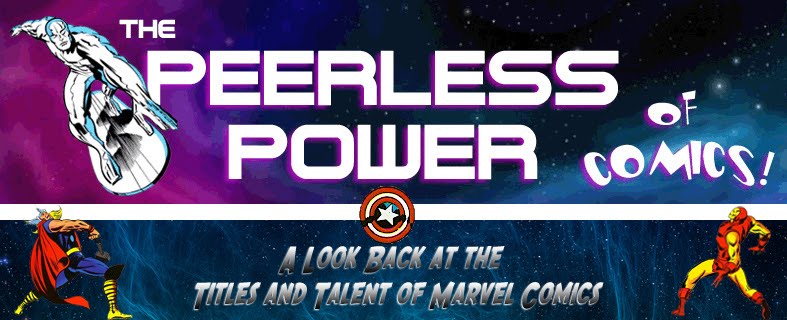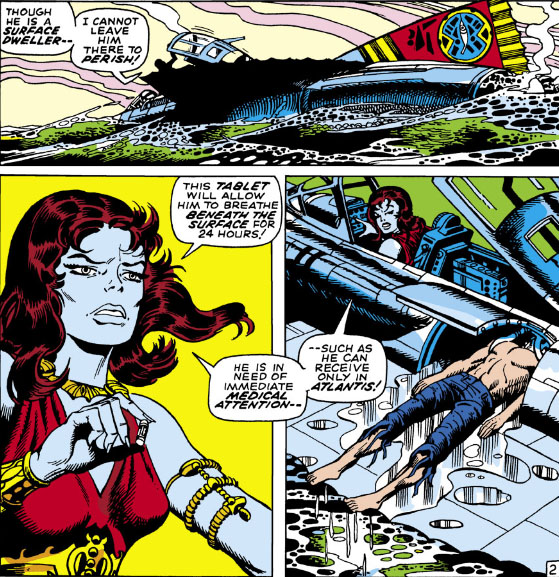It's no small task to try to follow up on the first all-out Hulk/Sub-Mariner clash that we saw at the close of the Tales To Astonish series--written by Stan Lee, pencilled by Marie Severin, and inked by the late, great Dan Adkins. But eighteen issues into the Hulk's solo title, Lee attempts to bring these two together again to slug it out in "A Clash of Titans," a phrase which would endure and serve to apply to future battles between those Marvel characters that fans most wanted to see in battle and give no quarter in a cover-to-cover fight.
With this second fight, though, Lee dilutes the action by reinventing the wheel to a certain extent with some of the elements of the first fight--with the exceptions that this time, the Hulk isn't taken over and forced to engage Namor, nor does the fight take place in a busy city amongst startled (and no doubt fearful) onlookers. In fact, the revised circumstances for the most part are sensible: the lady Dorma comes across an unconscious man floating in the ocean, and takes him to Atlantis to recover while also hoping the act will help to facilitate peace between Atlantis and the surface world. The man, of course, is Bruce Banner, whom she doesn't recognize (nor should she).
To be honest, it took me a few readings to get on board with this story--partly because, even though the story takes roughly the same amount of pages as the first, it still has more of a "rushed" feel to it. Banner is in this issue as a virtual cameo, only really present to turn into the Hulk; and once the fight is over, the ending is so tidy and has such similarities with that of the first story that you wonder if you've simply read a variation of what's come before. Yet, with the new material Lee does inject, it's still a visually impressive fight between the two, considering that the Hulk this time is battling with the full possession of his faculties (such as they are) and there's no constant worry on Namor's part about weakening out of his natural element. And one certainly can't complain about the artwork--pencilled and inked by Herb Trimpe, whose depiction of an underwater battle between Namor and the Hulk doesn't get nearly the elbow room that it deserves.
And let's face it, the man can draw great hardware.
So the stage is practically set, with Dorma taking Banner back to Atlantis where Namor, typically, is ranting about surface dwellers. But there's one more character to introduce, who serves to instigate the upcoming action--Mistress Fara, who wants to usurp Dorma's standing with Namor and now sees her opportunity.
I know what you're thinking, but have some faith--Namor isn't going to fly off the handle here, just on Fara's word. He's the prince of Atlantis, leader of his people. And Dorma is one of the most trusted of his inner circle, not to mention close to his heart. He's going to keep a cool head and have a leader's perspective, examining all the evidence and...
Who are we kidding.
Namor doesn't just fly off the handle--he snaps it in two for good measure.
And guess what all this shouting does to the guy waking up in the other room:
Since this story is called "A Clash of Titans," what are the odds that Namor isn't going to follow up one misassumption with another? Fortunately, the Hulk had it figured out before we did.
From this point forward, Trimpe kicks the action into high gear. And this time, the Hulk isn't interested in stopping the fight, or needing to deal with any force controlling him. He and Namor are in a true clash this time, with no excuses given and no punches pulled.
And remember this little maneuver?
In the prior battle, this tactic served to effectively end the fight as well as the involvement of the Puppet Master. And while the Hulk has equal difficulty here with this type of trap, this time he's not as distracted and has far more resolve, particularly in proving that he's mightier than any force used against him. And, like Quicksilver, Namor encircling his foe repeatedly only makes him a predictable target.
It's at this point that Lee resolves the situation with Mistress Fara--who didn't succeed at framing Dorma as a traitor, but takes advantage of Dorma lying prone at the battle site to make it appear as if she became a casualty of the fight. Yet Fara will fail--not because she's a lousy shot, but because she's apparently willing to ignore the klaxon going off in her head that the rest of us would have had the good sense to listen to, telling her not to approach the vicinity of a Hulk/Sub-Mariner battle.
Ironically, Fara ends up saving the one she meant to assassinate, when her own body shields Dorma's from the falling rubble. Which is just as well, because she probably would have lost more than her station had she lived to face Namor's justice.
Once Namor rescues Dorma, his thirst for battle with the Hulk evaporates, since it was Dorma who had pleaded with him not to fight (well, for all of two seconds). The Hulk, though, is still itching for a fight, and launches himself at Namor like a torpedo.
But it's here I found myself losing my thirst for this fight, since now only one of its titans wishes to clash. And with Namor now shifting back to leadership mode, as a reader you have a feeling of the battle winding down. There are also the mechanics of the situation: the Hulk as a living torpedo might have made sense in a short-range attack on Namor, but not in a situation where Namor is far enough away to not only have ample warning of the Hulk's approach but also time enough to meet him head-on.
And, while we're at it, why head-on? Certainly to satisfy the demands of a comic book story--but Namor could have handled the Hulk's approach in other ways, any of which would have minimized if not eliminated any subsequent repercussions. The Hulk's options are limited to one: following one course to collide with his enemy. He can't maneuver as Namor can, and his act depends on a head-to-head collision. Namor, on the other hand, has shockwaves in the vicinity of his kingdom to worry about, to say nothing of Dorma's safety--why should he indulge the Hulk like this?
For what it's worth, any course of action Namor took might have resulted in this fight ending in a draw, given his current state of mind about it. As it happens, the collision sends both combatants into opposite directions like rockets--Namor through the water, and the Hulk out of the ocean and soaring toward land. Once Namor is able to recover, he does something else inexplicable--heading off to see to the Hulk's safety, rather than to check on the state of Atlantis or Dorma.
As to those similar endings, you be the judge. Looking first at the original story's ending and, following, the more recent concluding scene, do you get a sense of déjà vu here?
Which was another factor in making me feel as if this fight was just a reworking of the original with slight variations. To recap: We had an outside, disreputable source instigating it. We had the same type of ending. We had the same whirling water pressure trap. But in comparison, we also had noticeably less action. In the original, we ended up feeling like the battle, however inconclusive, had gone the distance; whereas in this one, how many punches do you recall seeing either combatant land on the other? Would you believe one? These two are evenly matched, at last--we're going to tie their hands now?
Interestingly, this kind of marquee battle was never duplicated in the Sub-Mariner's book (which certainly could have benefited from the exposure and resulting sales), unless you count the brief skirmish in the "Titans Three" storyline. The two would go on to have dust-ups in The Defenders--though with other characters to be dealt into those stories, their "clash" time would have limited page space as well as efforts made to separate them. So, for a time, "A Clash of Titans" would have to stand as the only other significant meeting between them which justified the use of such a bold, informal promise of unleashed action in its title. Perhaps it's worth noting that something like "Titans Unleashed!" might have instead necessitated raising the action quotient for this battle considerably.





















No comments:
Post a Comment